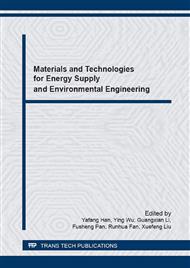[1]
J. Wei, Z. Liu, Y. Zhang, Rheological properties of amorphous poly alpha olefin (APAO) modified asphalt binders. Construction and Building Materials. 48(2013)533-539.
DOI: 10.1016/j.conbuildmat.2013.07.087
Google Scholar
[2]
X. Zhou, S. Wu, Q. Liu, Z. Chen, M. Yi, Effect of Surface Active Agents on the Rheological Properties and Solubility of LDHs Modified Asphalt. Mater Res Innov. 19(2015) S5-978-S5-982.
DOI: 10.1179/1432891714z.0000000001233
Google Scholar
[3]
P. C. Sousa, Automated protocol for analysis of dynamic mechanic analyzer data from fine aggregate asphalt mixes. Texas A&M University, (2010).
Google Scholar
[4]
L. Mo, M. Huurman, S. Wu, A.A. A . Molenaar, Mortar fatigue model for meso-mechanistic mixture design of ravelling resistant porous asphalt concrete. Materials and Structures. 47(2014) 947-961.
DOI: 10.1617/s11527-013-0105-6
Google Scholar
[5]
L. Mo, M. Huurman, S. Wu, A.A.A. Molenaar, Research of Bituminous Mortar Fatigue Test Method Based on Dynamic Shear Rheometer. J Test Eval. 1(2012)84-90.
DOI: 10.1520/jte103738
Google Scholar
[6]
Y.H. Huang, Pavement analysis and design. 2nd ed. Upper Saddle River: Pearson Prentice Hall, (2004).
Google Scholar
[7]
S. Mindess, J.F. Young, D. Darwin, Concrete. 2nd ed. Upper Saddle River: Prentice Hall, (2003).
Google Scholar
[8]
L.T. Mo, M. Huurman, S.P. Wu, A.A.A. Molenaar, Ravelling investigation of porous asphalt concrete based on fatigue characteristics of bitumen-stone adhesion and mortar. Materials and Design. 30(2009)170-179.
DOI: 10.1016/j.matdes.2008.04.031
Google Scholar
[9]
L.T. Mo, M. Huurman, S.P. Wu, A.A.A. Molenaar, Bitumen-stone adhesive zone damage model for the meso-mechanical mixture design of ravelling resistant porous asphalt concrete. Int J Fatigue. 33(2011)1490-1503.
DOI: 10.1016/j.ijfatigue.2011.06.003
Google Scholar
[10]
M. Guo, Interfacial behavior of asphalt mastics and its mechanism. Harbin Institute of Technology, (2012).
Google Scholar
[11]
L. Zhang, M.L. Greenfield, Analyzing properties of model asphalts using molecular simulation. Energy Fuels. 21(2007)1712-1716.
DOI: 10.1021/ef060658j
Google Scholar
[12]
H.G. Groenzin, O.C. Mullins, Molecular size and structure of asphaltenes from various sources. Energy Fuels. 14(2000)677-684.
DOI: 10.1021/ef990225z
Google Scholar
[13]
D. Cheng, D.N. Little, A.M. Lytton, J.C. Holste, Use of surface free energy properties of the asphaltaggregate system to predict moisture damage potential. Journal of the Association of Asphalt Paving Technologists. 71(2002)59-88.
Google Scholar
[14]
T.Y. Pan, A first-principles based chemo-physical environment for studying lignins as an asphalt antioxidant. Construction and Building Materials. 36(2012) 654-664.
DOI: 10.1016/j.conbuildmat.2012.06.012
Google Scholar


